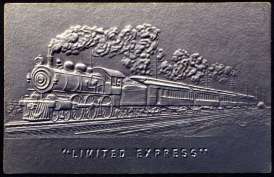PAN-AMERICAN EXPOSITION ISSUE - May 1, 1901
2¢ Early Locomotive
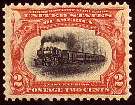
Scott 295, Issued May 1, 1901 - 2c carmine & black - 4-4-0 locomotive
No. 938 & passenger cars "Empire State Express," New York Central & Hudson River Railroad
This is my favorite US stamp, not only for its quintessential train
image, but also the classic bi-color engraved design.
|
4¢ Railroad passenger vehicle

Scott 296, Issued May 1, 1901 - 4c deep red-brown & black - Baltimore & Ohio Railroad passenger vehicle
The first automobile depicted on a stamp, this electric hansom cab was used by the B&O Railroad for conveying
travelers and their baggage to and from the B&O station in Washington, D.C.
(Linn's Stamp News, 10/19/98, Pg. 12)
|
5¢ Bridge at Niagara Falls
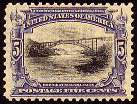
Scott 297, Issued May 1, 1901 - 5c ultramarine & black - Streetcars on
Honeymoon Bridge, Niagara Falls, 1898
|
Trains? Well, sort of.
Ordinarily I do not collect the items without an actual train,
so I would not be showing the two above,
but I thought it worth demonstrating the zeal
of my fellow train-stamp collectors in finding such connections.
|
|
The annual report of the Third Assistant Postmaster General for 1900
announced the Pan-American Issue as follows:
"At the instance of the authorities of the Pan-American Exposition to be held at Buffalo, NY, from May 1 to October 1,
1901, the Postmaster General has authorized the issue of a special series of postage stamps to commemorate the
exposition, which owing to its magnitude and international character is fairly entitled to this mark of recognition by
the Post Office Department. The new stamps will be furnished to all postmasters upon their requisition, and the first
issue will be made at the time the exposition is inaugurated, May 1, 1901, the stamps being withdrawn at the close of
the exposition, October 31.
"It has been decided to issue these stamps in six denominations, 1, 2, 4, 5, 8, and 10 cents, and to make them the most
artistic series ever issued by the Department. The Bureau of Engraving and Printing has cooperated to this end and has
consented to print the issue in two colors, an undertaking which involves considerable difficulty, particularly in view
of the enormous amount of other work required of it. The Bureau of Engraving and Printing took control of the
manufacture of postage stamps in July, 1894, and has steadily improved the character of this work up to date. In
executing the wishes of the Department as to the Pan-American series, it has thus far equaled all expectations. The
result is a stamp that will, I believe, at once delight the eye and otherwise gratify the Department and the public.
The designs selected represent the latest and most improved modes of transportation and auxiliaries thereto, as appears
from the following descriptions:
| Denomination |
Subject |
Color |
Legend |
| 1 cent |
Lake steamer |
Green |
Fast lake navigation |
| 2 cents |
Railway train |
Red |
Fast express |
| 4 cents |
Automobile |
Red-brown |
Automobile |
| 5 cents |
Steel-arch bridge |
Blue |
Bridge at Niagara Falls |
| 8 cents |
Ship-canal locks |
Lilac |
Canal locks at Sault Sainte Marie |
| 10 cents |
Ocean steamship |
Light brown |
Fast ocean navigation |

Sc. 294
|

Sc. 295
|

Sc. 296
|

Sc. 297
|

Sc. 298
|
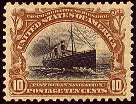
Sc. 299
|
ONE CENT - The lake steamer presents the port bow, the pilot house is well forward, and it is propelled by side
wheels.
TWO CENTS - The train of four cars is drawn by a locomotive with four drivers; four parallel tracks are shown.
FOUR CENTS - The automobile is of the closed-coach order, with two men on the box and a part of the United States
Capitol at Washington as a background.
FIVE CENTS - this presents the largest single span steel bridge in the world; two trolley cars are seen upon it, and a
full view of Niagara Falls is show under, beyond, and up the river, with the graceful springing arch as a frame.
EIGHT CENTS - The great ship-canal locks at Sault Sainte Marie, Mich., are given in a view from a higher point,
including the immediate surroundings.
TEN CENTS - An ocean steamship of the American line, with two smokestacks and masts, presents it starboard bow, lapped
by a rising wave."
(from The Postage Stamps of the United States by John Luff, 1902)
|
I quote the text above as much for the charming quaintness of the wording as for the content - as jaded as we are
today with computers, the Internet, Palm Pilots, space shuttles, the Hubble Telescope, open-heart surgery, Hollywood
special effects, etc., it is refreshing to think of a time, a mere century ago, when the images shown represented the
state-of-the-art in transportation and technology.
The Pan-American Exposition stamps were issued in conjunction with the
The Pan-Am Expo in Buffalo, NY, in 1901.
The Expo had been planned for 1900, to celebrate the new century, but delays made the promoters put it off a year.
Since the Expo had been organized with the support and approval of the US government, it was only natural that special
stamps should be issued to advertise it, as they had been for the World's Columbian Expo in Chicago in 1893, and the Trans-
Mississippi Expo in Omaha in 1898. To give the stamps added appeal, they were printed in two colors, which had been
done only once before on US postage stamps, and had to be "sold" to the Bureau of Engraving and Printing, against their
vigorous objections, as a way of proving their "artistic craftsmanship" (hence, presumably, the elaborate praise in the
official release announcement above).
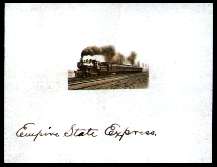
The image above is a "photo essay" of the vignette (central image) used for Scott 295, offered for sale
as Lot 327 in the Shreves
2002 Premier Sale, March 8-9, 2002. Estimated value was $500-700. Sold for $700.
The catalog text reads as follows:
#295E, 2c Pan-American, vignette photo essay, a photo reduction from the files of the Post Office Dept., with manuscript
"Empire State Express" in the hand of the chief clerk and later acting 3rd Assistant Postmaster General Arthur M.
Travers, very fine; likely unique; ex-Rosenthal.
Identification of the steam locomotive used as a model for the stamp was published in Stamps magazine, 22nd May
1937.
Collector Allan M. Thatcher located the original photograph in the collection of a one-time famous railway photographer
C. B. Chaney. The Chaney photograph was of locomotive No. 938 hauling the Empire State Express.
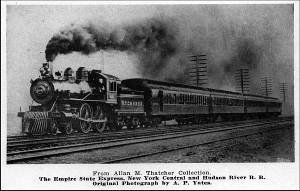
Mr. Thatcher must have done further research after he wrote that Stamps article, because in 1947 Max Johl,
in his essential The U.S. Commemorative Stamps of the 20th Century, published that photograph, with the
source given as Allan M Thatcher, but the photographer given as A.P. Yates.
And yes, the number 938 is clearly discernible on its nose.

Moreover, that photo seems to have been reproduced widely near the time it was created, as I have three embossed
postcards (see top of this page for one) with the same image, though oddly the locomotive has been changed to
a 4-6-0, and an extra passenger car has been added!
Here is part of what Johl wrote about the design and production of the stamp:
The central feature of this stamp is a picture of the EMPIRE STATE
EXPRESS of many years ago, operated by the New York Central and Hudson
River R. R. The photograph was taken by A. P. Yates of Syracuse, while the
train was going sixty miles an hour. It depicts a train of four cars drawn by a
four driver locomotive ? four parallel tracks are seen.
The design was drawn by R. Ostrander Smith and the engraving for both
the vignette and frame was done by Messrs. Baldwin and Ellis, of the Bureau,
these three gentlemen being also responsible for the four, five, eight and ten cent
stamps of this series.
The Empire State Express, shown on this stamp, was selected by the Post
Office Department after the urgent solicitation on the part of G. H. Daniels,
at that time General Passenger Agent of the New York Central Railroad. He
argued that more had been written about it than all other trains ever placed in
service and the resultant advertising had been one of the greatest factors in
bringing before the other nations of the world the superiority of American
machinery and manufacturing. He further explained that as the Pan-American
Exposition was to be held in Buffalo and that the New York Central being
primarily a New York institution, the Empire State Express was a logical
subject to be used.
Information about No. 938 is scant and sometimes contradictory, but we know that it was a standard locomotive of class
870 built by the Schenectady Locomotive Works from 1891 onwards. 870's had 78" driving wheels, a length of 57' 1-3/4"
with tender, and weighed 53.6 tons. (Data quoted from "American Locomotives" by John H. White, Jr., published by Johns
Hopkins Press, Baltimore).
There were over 200 million copies of the 2-cent stamp distributed. As in the series of 1869, the train stamp was the
most
widely used of this series, since it paid the basic letter rate, 2¢ per oz. A decent used copy can be purchased
for $1, and $20 should get one an attractive copy unused. There are several color varieties listed in Scott, but
none with any additional value. Scott also lists a double transfer, with a value of only $25, so it is either
common or too subtle to be in demand.
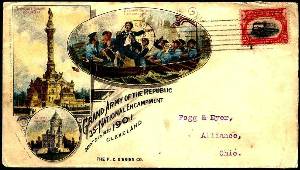
Sc. 295 on Advertising Cover
|

Sc. 295 on Advertising Cover
|
|
Nice copies on advertising covers like the one on the left above are particularly desirable.
The cover on the right even has an RPO cancel, and a couple of trains in its cachet.
|

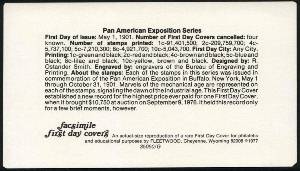
Sc. 294-298 on First Day Cover
|
|
How about a First Day Cover? The scan above is from a reproduction sold by Fleetwood.
|
As everyone expected when the use of two-color printing was announced,
invert errors of three of the stamps (294, 295, and 296)
slipped through the quality control process and reached the public.
The single of 295a above, one of the finest known, last sold for $60,000,
the single of 296a (attractive, but less than perfect) sold for $15,000,
while the block of four of 295a last sold for almost $150,000! (No, I don't own any of them -
my thanks to Siegel Auction Galleries for permission to scan the image from their catalogs.) For more
about inverts in general, visit my "I" is for Invert Error page, where you will
also find more about the Pan-Am Inverts.
In 2001 the USPS issued a souvenir sheet with reproductions of the
Pan-Am Inverts.
And if you would like to see my page showing poster stamps and other ephemera from
the Pan-Am Expo, click here.
|




